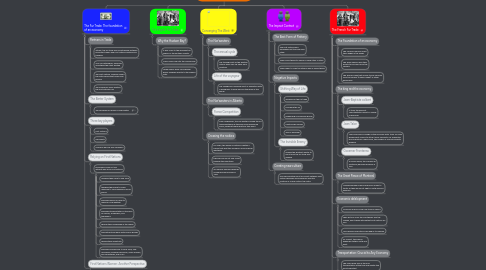
1. The Fur Trade: The foundation of an economy
1.1. Partners in Trade
1.1.1. Initially, the fur trade was a partnership between European traders and First Nations hunters and trappers.
1.1.2. As in all partneships, each had something the other wanted
1.1.3. The First Nations peoples valued the metal goods that came from Europe
1.1.4. The Europeans really wanted the First Nations furs
1.2. The Barter System
1.2.1. The exchange of goods is called barter
1.3. Three key players
1.3.1. First Nations
1.3.2. Merchants
1.3.3. Coureurs de bois and voyageurs
1.4. Relying on First Nations
1.4.1. Europeans could not live without help from First Nations
1.4.1.1. Showing them how to find food
1.4.1.2. teaching them how to make medicine to cure diseases such as scurvy
1.4.1.3. providing advice on how to dress for cold weather
1.4.1.4. providing transportation in the form of canoes, snowsheos, and toboggans
1.4.1.5. sharing thier knowledge of the region
1.4.1.6. translating trade deals with various groups
1.4.1.7. helping them negotiate
1.4.1.8. providing a workforce to cook food, sew moccasins, prepare pemmican, snare animals, lace snowshoes, and so on
1.5. First Nations Women: Another Perspective
1.5.1. Preparing furs
1.5.2. working in forts
1.5.3. working "on the road"
1.5.4. sharing language and geography skills
2. The French Fur Trade
2.1. The Foundation of an economy
2.1.1. The coureurs de bois spent thier wages in the shops
2.1.2. The shop owners used thier profits to buy food from the farmers
2.1.3. The farmers used that money to buy services from the cooper (a barrel maker) or other businesses
2.2. The king and the economy
2.2.1. Jean-Baptiste colbert
2.2.1.1. In 1663, the king put Jean-Baptiste Colbert in charge of planning.
2.2.2. Jean Talon
2.2.2.1. Jean Talon was in charge of the economy after 1665. He used government money to attract more colonists. He supported local industries. Under Talon, the number of French colonists doubled
2.2.3. Governer Frontenac
2.2.3.1. A French noble, the Marquis de Frontenac,became governer in 1672
2.3. The Great Peace of Montreal
2.3.1. Haudenosaunee+French and huron made to treaty so they would not fight in north america anymore
2.4. Economic delelopment
2.4.1. Coureurs de bois could now travel in peace.
2.4.2. They got furs from the Montagnais and the Odawa, who traded with distant First Nations for furs.
2.4.3. Local beaver populations had begun to dwindle.
2.4.4. As a result, the French expanded farther north and west.
2.5. Transportation: Crucial to Any Economy
2.5.1. The rivers were one of the only transportation at the time and defitily the most important
2.6. Expanding trade
2.6.1. The French made good use of the First Nations' knowledge of transportation routes
3. The English Fur Trade
3.1. Why the Hudson Bay?
3.1.1. It was close to the abundant fur supply of the northern forests.
3.1.2. Many rivers flow into the Hudson Bay
3.1.3. Large supply ships could deliver heavy supplies directly to the english forts.
4. Converging The West
4.1. The Nor'westers
4.1.1. The annual cycle
4.1.1.1. The trading posts of the western interior were very far away from Montreal
4.1.2. Life of the voyageur
4.1.2.1. The voyageurs combined spirit of adventure with a willingness to work hard for the good of the group.
4.2. The Nor'westers in Alberta
4.2.1. Fierce Competition
4.2.1.1. From Chipewyan, the Nor'westers carried the fur trade westward up the peace and mackenzie rivers, building trading posts as they went
4.3. Crossing the rockies
4.3.1. For years, the Rocky Mountains created a barrier that kept the voyageurs from pushing westward.
4.3.2. Explorers could not find a way through the mountians.
4.3.3. An explorer named Alexander Mackenzie found a way in 1789.
5. The Impact Contact
5.1. The Best Form of Flattery
5.1.1. The First Nations and Europeans got to know each other.
5.1.2. They found things to admire in each other' culture.
5.1.3. They began to copy the other's way of doing things.
5.2. Negative Impacts
5.2.1. Shifting Way of Life
5.2.1.1. Working for the fur trade
5.2.1.2. Following the fur
5.2.1.3. Depending on European goods
5.2.1.4. Hunting The buffalo
5.2.1.5. loss of language
5.2.2. The Invisible Enemy
5.2.2.1. Pehaps the greatest diaster to result from the fur trade was disease
5.3. Creating new culture
5.3.1. One very positive result of conact between First Nations peoples and Europeans was the creation of a new culture: the Metis

